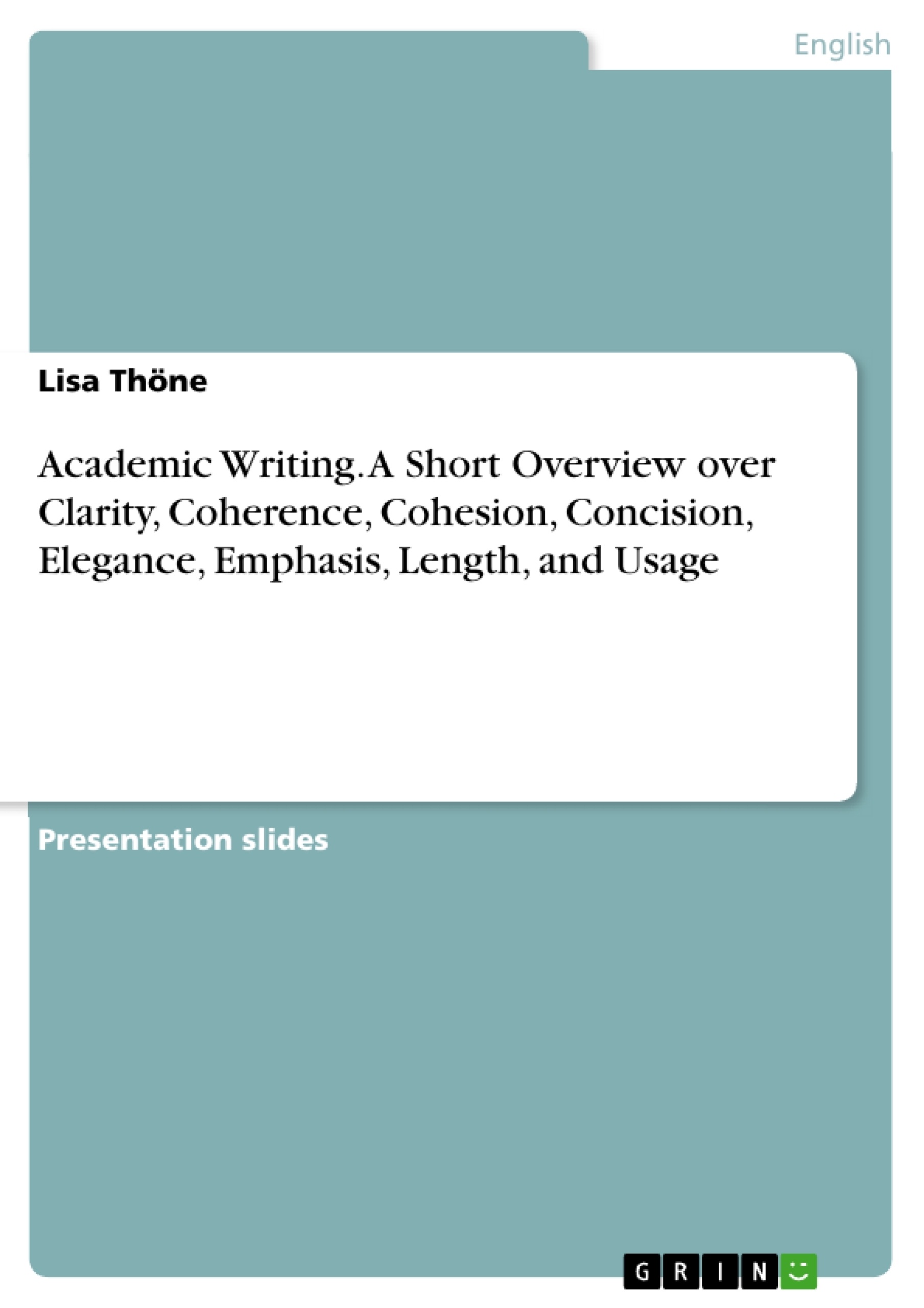This presentation shows the most essential aspects of academic writing. This will help you to stay focused and write reader-friendly texts.
Table of Contents
- What is Clarity in Writing?
- What is Clarity in Writing?
- Important Aspects
- Important Aspects – Summing Up
Objectives and Key Themes
The main objective of this text is to explore the concept of clarity in academic writing and provide strategies for achieving it. The text aims to guide writers towards producing clear and direct prose that is easily understood by the reader.
- The definition and importance of clarity in writing
- Techniques for achieving sentence-level clarity
- The role of verbs and subjects in clear writing
- The importance of active voice and direct expression
- Strategies for improving overall writing coherence
Chapter Summaries
What is Clarity in Writing?: This initial section introduces the core concept of clarity in academic writing, emphasizing its crucial role in effective communication. It highlights the importance of considering the reader's perspective and suggests taking short breaks during the writing process to maintain objectivity and improve clarity. The section implicitly advocates for a reader-centered approach to writing, emphasizing the need for the writer to anticipate and address potential reader misunderstandings.
What is Clarity in Writing?: This chapter, while having the same title as the first, provides further elaboration on the concept of clarity. It suggests external resources, like the YouTube video "Sentence Clarity," to further expand understanding. The chapter sets the stage for subsequent discussions on practical strategies to enhance clarity in writing. Although short, it reinforces the introductory concept by pointing the reader to additional information, indicating that clarity is a multifaceted topic requiring a thorough approach.
Important Aspects: This chapter delves into the practical application of achieving clarity, focusing on specific techniques. It utilizes examples to illustrate how expressing actions and conditions in specific verbs, adverbs, or adjectives improves clarity. The chapter stresses the importance of making the subjects of verbs the characters involved in the actions. The examples provided highlight how active voice and direct writing style significantly contributes to clarity. This sets the groundwork for more advanced discussion in the following chapter.
Important Aspects – Summing Up: This concluding section summarizes the key takeaways from the preceding chapter. It reiterates the importance of expressing crucial actions in verbs and central characters as subjects to achieve clear and direct prose. However, it importantly emphasizes that this is just a first step towards achieving coherent writing. This chapter provides a synthesis of previously introduced concepts and provides a bridge to future considerations and advancements in the pursuit of effective clarity in writing.
Keywords
Clarity, academic writing, sentence structure, verbs, subjects, active voice, direct writing, coherence, reader-centered writing, writing process.
Frequently Asked Questions: A Guide to Clarity in Academic Writing
What is the main objective of this text?
The primary goal is to explore the concept of clarity in academic writing and offer practical strategies to achieve it. It aims to guide writers in producing clear and easily understandable prose.
What are the key themes covered in this text?
The text covers the definition and importance of clarity, techniques for achieving sentence-level clarity (focusing on verbs and subjects), the advantages of active voice and direct expression, and strategies for improving overall writing coherence. It emphasizes a reader-centered approach.
What topics are discussed in the "What is Clarity in Writing?" chapters?
The two chapters with this title introduce the core concept of clarity. The first emphasizes the importance of considering the reader's perspective and maintaining objectivity. The second reinforces this concept and suggests additional resources, such as the YouTube video "Sentence Clarity," to further enhance understanding.
What practical techniques for achieving clarity are explained?
The "Important Aspects" chapters delve into practical application. They highlight the importance of using specific verbs and adverbs/adjectives to express actions and conditions clearly. Emphasis is placed on making the subjects of verbs the characters performing the actions, advocating for active voice and a direct writing style.
How does the text summarize the key takeaways?
The concluding section summarizes the importance of expressing actions in verbs and central characters as subjects. It emphasizes that this is a foundational step towards coherent writing, suggesting further development is needed for truly effective clarity.
What are the key terms associated with this text?
Key terms include: Clarity, academic writing, sentence structure, verbs, subjects, active voice, direct writing, coherence, reader-centered writing, and writing process.
What is the structure of the text preview?
The preview provides a comprehensive overview including the title, table of contents, objectives and key themes, chapter summaries, and keywords.
Where can I find additional information on sentence clarity?
The text suggests exploring the YouTube video "Sentence Clarity" as a supplementary resource for further learning.
- Quote paper
- Lisa Thöne (Author), 2023, Academic Writing. A Short Overview over Clarity, Coherence, Cohesion, Concision, Elegance, Emphasis, Length, and Usage, Munich, GRIN Verlag, https://www.grin.com/document/1478767




